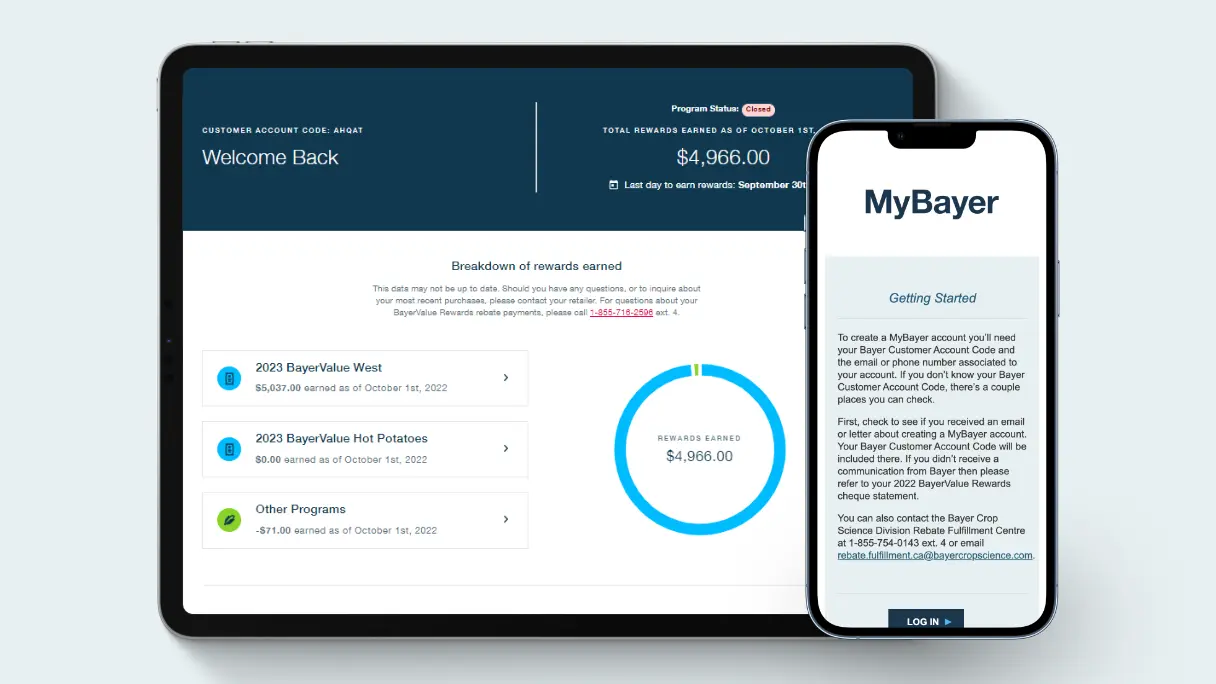Roundup WeatherMAX
fs-approved-use: AB, BC, MB, NB, NL, NS, NT, NU, ON, PE, QC, SK, YK
title-product-highlights
Proven crop safety on Bayer glyphosate-tolerant trait systems
Excellent and consistent weed control under ideal and tough conditions
30-minute rainfast guarantee*
Enhanced efficiency with a 540 g/L formulation
All weather warranty
- *Rainfast guarantee, service and support and weather warranty provided through the RiskShield® Protection Package. Terms and conditions apply. Visit roundup.ca for more information.
product-details-heading
| crops | category | groups-active-ingredients | formulation-type | packaging |
|---|---|---|---|---|
• Canola • Cereals • Corn • Soybeans | • Non-Selective Herbicide | 9 Glyphosate | Liquid concentrate herbicide
Water soluble
540g/L formulation | • 10 L jug = 8 to 30 ac. • 115 L drum • 450 L tote • 800 L tote |
| crops |
|---|
• Canola • Cereals • Corn • Soybeans |
| category |
|---|
• Non-Selective Herbicide |
| groups-active-ingredients |
|---|
9 Glyphosate |
| formulation-type |
|---|
Liquid concentrate herbicide
Water soluble
540g/L formulation |
| packaging |
|---|
• 10 L jug = 8 to 30 ac. • 115 L drum • 450 L tote • 800 L tote |
| weeds-controlled |
|---|
• Field bindweed • Annual bluegrass • Canada bluegrass • Kentucky bluegrass • Annual broadleaf weeds |
| weeds-controlled |
|---|
• Field bindweed • Annual bluegrass • Canada bluegrass • Kentucky bluegrass • Annual broadleaf weeds |
title-use-mixing

- application-guidelinesexpand_more
- 1The 0.22 L/ac. rate can be used for control of shepherd’s purse, cow cockle and night-flowering catchfly at the 1– 3 leaf stage of the crop or for control of smartweed at the 4 –6 leaf stage. Repeat applications may be required if a second flush of weeds germinates prior to canopy closure.
- 2 Biennial wormwood should be at 2 to 8 leaf stage and actively growing.
- 3 For control of volunteer adzuki beans (unifoliate to the fourth trifoliate leaf stage) apply 0.67 L/ac. A second 0.67 L/ac. application may be used for late flushes emerging after the initial treatment. Adzuki beans should be at unifoliate to fourth trifoliate leaf stage and actively growing.
| table-content-cropName | table-content-pests-herbicide | table-content-stage | table-content-rate | table-content-notes |
|---|---|---|---|---|
| Barley Bean, Dry Canola Corn Canary Seed Flax Lentils Oats Pea Soybeans Summer Fallow- Chemfallow Wheat | Please refer to label for complete list of weeds controlled and suppressed. | Refer to label | Refer to label | |
| TruFlex™ Roundup Ready canola varieties | Annual Grasses Barnyard grass, green foxtail, volunteer barley, volunteer wheat, wild oats Annual Broadleaves Chickweed, cleavers, corn spurry, cow cockle1, flixweed, hemp-nettle, kochia, lady’s-thumb, lamb’s quarters, narrow-leaved hawk’s beard, night-flowering catchfly1, non-Roundup Ready volunteer canola (rapeseed), redroot pigweed, Russian thistle, shepherd’s purse1, smartweed1, stinkweed, stork’s-bill, wild buckwheat, wild mustard, wild tomato Perennials (Suppression) Canada thistle, dandelion, perennial sow thistle and dandelion Perennials (Season-long control) Quackgrass | Emergence to first flower | 0.22 to 0.33 L/ac. single application | When 50% of the plants in the field have more than one flower. Ensure the crop has not advanced beyond the recommended growth stage for all applications. Maximum 1.33 L/ac. is allowed for the post emergence use. |
| TruFlex™ Roundup Ready canola varieties | All the above weeds plus Perennials (season-long control) Canada thistle, and perennial sow thistle | Emergence to first flower | 0.51 L/ac. single application | |
| TruFlex™ Roundup Ready canola varieties | All the above weeds plus round-leaved mallow Perennials (season-long control) foxtail barley, Canada thistle | Emergence to first flower | 0.33 L/ac. sequential applications | When 50% of the plants in the field have more than one flower. Ensure the crop has not advanced beyond the recommended growth stage for all applications. Repeat applications may be required if a second flush of weeds germinates prior to canopy closure. Maximum 1.33 L/ac. is allowed for the post emergence use. For sequential applications, ensure the crop has not advanced beyond the recommended growth stage. |
| TruFlex™ Roundup Ready canola varieties | All the above weeds plus Biennial wormwood2, cocklebur, common ragweed, crabgrass (smooth and large), eastern black nightshade, fall panicum, foxtail (yellow and giant), foxtail barley, Pennsylvania smartweed, smooth pigweed, velvet leaf, volunteer adzuki beans3, wild proso millet, wire-stem muhly Common milkweed (suppression), yellow nutsedge (suppression) | Emergence to first flower | 0.67 L/ac. single application | When 50% of the plants in the field have more than one flower. Ensure the crop has not advanced beyond the recommended growth stage for all applications. Repeat applications may be required if a second flush of weeds germinates prior to canopy closure. Maximum 1.33 L/ac. is allowed for the post emergence use. |
| TruFlex™ Roundup Ready canola varieties | All the above weeds plus Perennials (season-long control) Bur cucumber, common milkweed, dandelion, field bindweed, horse nettle, tall waterhemp, yellow nutsedge | Emergence to first flower | 0.67 L/ac. sequential applications | When 50% of the plants in the field have more than one flower. Ensure the crop has not advanced beyond the recommended growth stage for all applications. Repeat applications may be required if a second flush of weeds germinates prior to canopy closure. Maximum 1.33 L/ac. is allowed for the post emergence use. A sequential application may be made at least 2 weeks after the first application. A second 0.67 L/ac. application may be used for late weed flushes emerging after the initial treatment. Common milkweed should be 15-60 cm in height and actively growing. Yellow nutsedge should be 5-15 cm in height and actively growing. Horse nettle (2 to 12-leaf stage). Tall waterhemp up to and including the 18 leaf stage. Bur Cucumber from the 1-to-18 leaf stage. |
| TruFlex™ Roundup Ready canola varieties | All the above weeds | Emergence to 6 leaf | 1.33 L/ac. single application | One application allowed in crop per season. |
- application-tipsexpand_more
- water-volumesexpand_more
- rainfastnessexpand_more
- tank-mixing-procedureexpand_more
title-additional-guidelines
- storageexpand_more
- resistance-managementexpand_more
